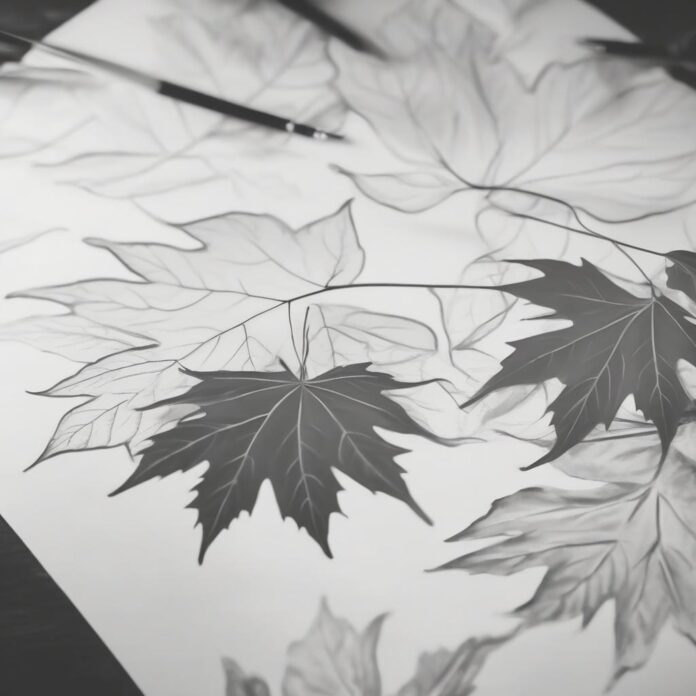-
Table of Contents
- How to Draw a Leaf: A Step-by-Step Guide
- Understanding Leaf Anatomy
- Gathering the Right Materials
- Step 1: Sketch the Basic Shape
- Step 2: Add the Veins
- Step 3: Define the Margins
- Step 4: Shade and Add Texture
- Step 5: Finalize the Details
- Summary
- Q&A
- 1. Can I use colored pencils instead of graphite pencils?
- 2. How can I make my leaf drawing look more realistic?
- 3. Are there any specific techniques for drawing different types of leaves?
- 4. Can I draw a leaf from my imagination without a reference image?
- 5. How long does it take to become proficient at drawing leaves?
Drawing is a wonderful way to express creativity and bring imagination to life. Whether you are an aspiring artist or simply looking for a new hobby, learning how to draw a leaf can be a great starting point. Leaves are not only beautiful and diverse in shape, but they also provide an opportunity to practice various drawing techniques. In this article, we will guide you through the process of drawing a leaf, step by step, providing valuable insights and tips along the way.
Understanding Leaf Anatomy
Before diving into the drawing process, it is important to have a basic understanding of leaf anatomy. Leaves consist of several key parts:
- Blade: The flat, expanded part of the leaf.
- Petiole: The stalk that connects the blade to the stem.
- Veins: The network of vessels that transport water and nutrients throughout the leaf.
- Margins: The edges of the leaf, which can be smooth, serrated, or lobed.
By familiarizing yourself with these basic components, you will be better equipped to capture the essence of a leaf in your drawing.
Gathering the Right Materials
Before starting your leaf drawing, gather the necessary materials. Here’s what you’ll need:
- Pencil: Choose a pencil with a medium hardness (HB or 2B) for sketching and outlining.
- Eraser: A kneaded eraser is ideal for easily removing mistakes without damaging the paper.
- Paper: Select a smooth, heavyweight paper that can handle shading and blending.
- Reference Image: Find a clear and detailed reference image of the leaf you want to draw. This will help you capture its unique characteristics.
Now that you have your materials ready, let’s move on to the step-by-step process of drawing a leaf.
Step 1: Sketch the Basic Shape
Start by lightly sketching the basic shape of the leaf using your pencil. Pay attention to the overall outline and proportions. Remember, leaves come in various shapes, such as oval, heart-shaped, or lobed. Look closely at your reference image to accurately capture the shape of the leaf you are drawing.
Step 2: Add the Veins
Next, add the veins to your leaf drawing. Veins play a crucial role in leaf structure and can vary in pattern and prominence. Observe the reference image and carefully draw the veins, ensuring they follow the natural flow of the leaf. Use light, gentle strokes to create a realistic effect.
Step 3: Define the Margins
Once the veins are in place, it’s time to define the margins of the leaf. Pay attention to whether the margins are smooth, serrated, or lobed. Use short, precise strokes to capture the texture and details of the leaf’s edges. Take your time and refer to the reference image as needed.
Step 4: Shade and Add Texture
Now that the basic structure of the leaf is complete, it’s time to add shading and texture to bring it to life. Start by identifying the light source in your reference image. This will help you determine where the shadows and highlights should be.
Use your pencil to lightly shade the areas of the leaf that are in shadow. Gradually build up the shading, using a combination of hatching and cross-hatching techniques. Pay attention to the subtle variations in tone and texture.
To create a more realistic effect, you can also use a blending stump or a cotton swab to blend the shading and soften harsh lines. This will give your leaf drawing a smoother and more polished appearance.
Step 5: Finalize the Details
As you near the end of your leaf drawing, take a step back and assess the overall composition. Look for any areas that need refinement or additional details. Add any necessary touches, such as small veins, imperfections, or variations in color.
Remember, no leaf is perfect, so embrace the natural irregularities and imperfections that make each leaf unique.
Summary
Drawing a leaf can be a rewarding and enjoyable experience. By following the step-by-step guide outlined in this article, you can learn how to capture the beauty and intricacies of a leaf in your artwork. Remember to start with a basic sketch, add the veins and margins, and then bring your drawing to life with shading and texture. With practice and patience, you will be able to create stunning leaf drawings that showcase your artistic skills.
Q&A
1. Can I use colored pencils instead of graphite pencils?
Absolutely! While this article focuses on using graphite pencils, you can certainly use colored pencils to add vibrant hues to your leaf drawing. Experiment with different colors and techniques to create unique and eye-catching effects.
2. How can I make my leaf drawing look more realistic?
Creating a realistic leaf drawing involves paying attention to details such as shading, texture, and proportions. Study real leaves and observe how light interacts with their surfaces. Practice different shading techniques and experiment with blending to achieve a more lifelike appearance.
3. Are there any specific techniques for drawing different types of leaves?
Yes, different types of leaves may require specific techniques to capture their unique characteristics. For example, if you are drawing a serrated leaf, pay close attention to the jagged edges and use short, sharp strokes to depict them. Similarly, if you are drawing a lobed leaf, focus on the distinct lobes and their proportions. Always refer to your reference image and adapt your techniques accordingly.
4. Can I draw a leaf from my imagination without a reference image?
While it is certainly possible to draw a leaf from your imagination, using a reference image can greatly enhance the accuracy and realism of your drawing. Reference images provide valuable guidance on shape, texture, and details that may be difficult to recreate solely from memory. However, as you gain more experience and confidence, you can start experimenting with drawing leaves from your imagination.
5. How long does it take to become proficient at drawing leaves?
Becoming proficient at drawing leaves, like any skill, takes time and practice. The more you draw, the more you will improve. It is important to be patient with yourself and enjoy the process of learning and experimenting. With dedication and perseverance, you will gradually develop your own unique style and become proficient at drawing









